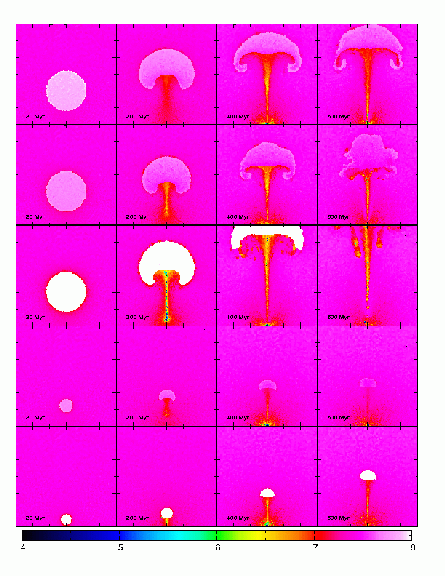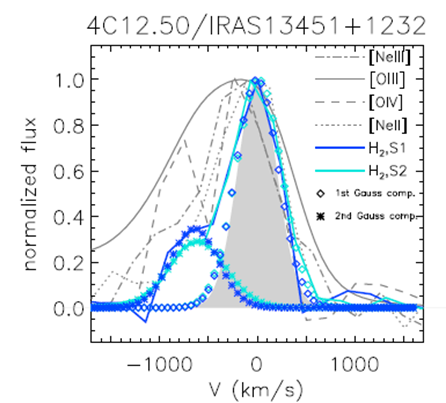|
|
Angular momentum transfer, fueling supermassive black holes (SMBH)

Main topics
- Dynamical processes for quick BH growth at high redshift

|
There is evidence from molecular observations that the black hole-bulge mass ratio in very young galaxies was higher than the present value
by a large factor. In particular in quasars at z~ 6, the ratio could be 15 times higher, as shown here by Wang et al (2010).
In these objets, the CO and far-infrared luminosities are still correlated, and follow the
same relationship defined by actively star-forming galaxies at all redshifts. This can be interpreted in terms of starbursts dominating
the dust heating. In these objects, the growth of bulges appear concommitant to the growth of super-massive black holes. However, the latter
might occur at a larger pace, compared to what is occuring in the local Universe. Dynamical models are run to explore this possibility.
|
- Statistical analysis of the role of various fueling mechanisms
|
Left: Torque map in NGC 6951 (colour scale), with superposed CO contours in the nucleus of the galaxy. The derived torques change sign as expected if the butterfly diagram, defined by the orientation of quadrants I-to-IV. The torques can be attributed to the action of the nuclear bar of NGC 6951.
Right: The torque per unit mass t(r) averaged over the azimuth and the fraction of the angular momentum dL/L transferred from/to the gas in one rotation are plotted. Torques are systematically negative over the nuclear spiral arms down to the inner radius of the pseudo-ring, r~300pc. In the vicinity of the AGN, torques become positive and AGN feeding is not presently favoured (Garcia-Burillo et al 2005).
Statistical studies will now be undertaken on much larger samples, with ALMA at high resolution, or with the SKA pathfinders at low
resolution.
|

|
- Simulations of the AGN feedback mechanisms


|

|
One of the best examples of AGN feedback in action: the regulation of cooling flows in galaxy clusters
Left
The movies represent the evolution of a plasma bubble during its migration in the hot cluster gas atmosphere. The plasma bubble is displayed in grey,
while particles of hot gas are in red and the cold gas in dark.
The ambient gas is trapped in the wake of the bubble and is dragged at higher radius, where it cools and falls back, forming cold gas filaments.
Right
Evolution of 5 different plasma bubbles in the hot intracluster medium. Each line represents a different model. Time increases from left to right.
In these plots, the colors represent the logarithm of the temperature (as shown by the palette at the bottom of the figure)
between 10 000 and 100 millions degrees (from Revaz et al 2008).
We will carry on numerical simulations of jet-driven cavities in fully dynamically evolved clusters, to explore the complex network of processes, which could involve some positive feedback in addition to negative feedback.
|
- Observations with IRAM and ALMA to probe AGN feedback
|
Left:
Detection in the H2 pure rotation lines of a molecular gas outflow in the radio source
4C12.50, possessing both an AGN and a straburst. The velocity of the outflow is 400-1000km.s,
and the amplitude 130 Mo/yr.
Right: Detection of the outflow inthe CO mm line, in absorption. The orange line
is the reverse HI absorption spectrum. From Dasyra & Combes (2012).
We will observe a large sample of them with IRAM and ALMA in the millimetre CO lines, which can be detected either in emission and absorption. .
|

|

|
|

